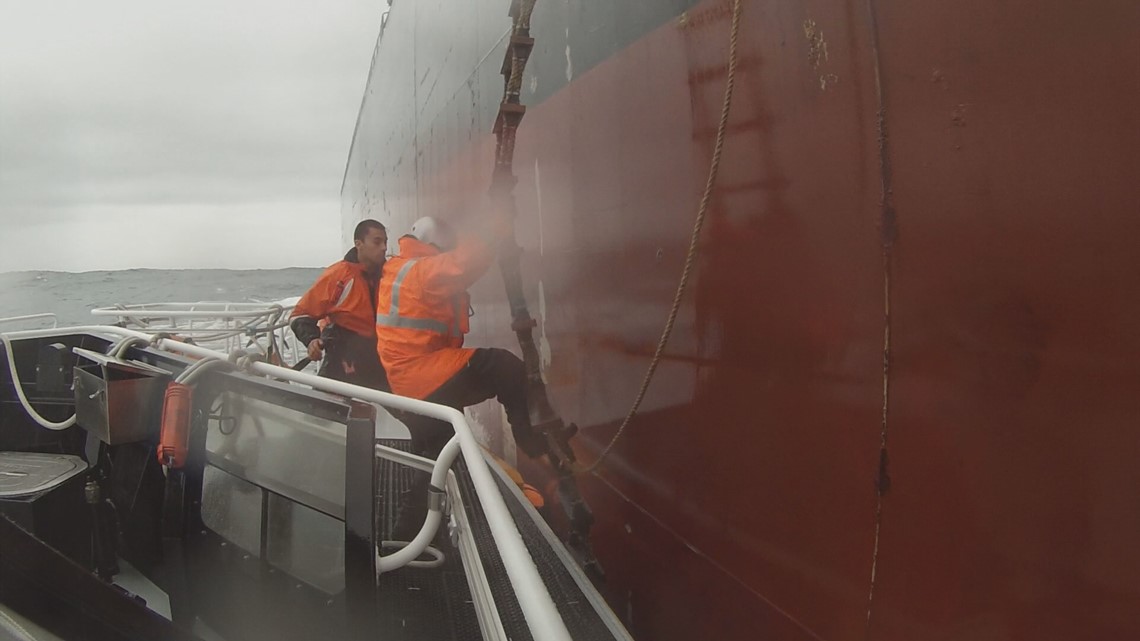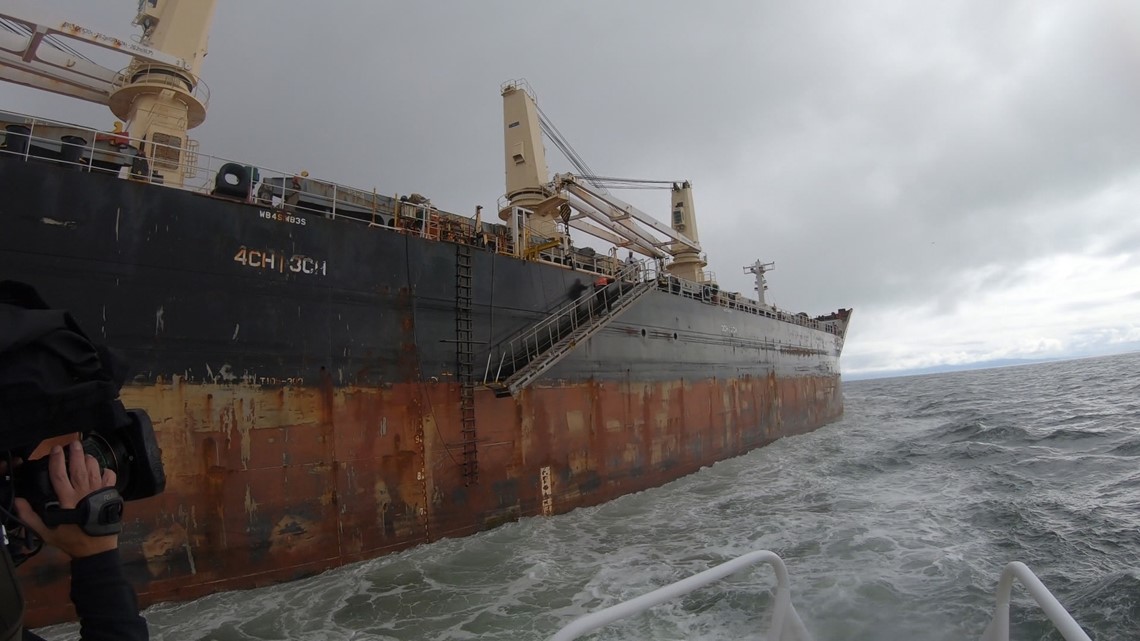ASTORIA, Ore. — After a runaway cargo ship caused the collapse of Baltimore's Francis Scott Key Bridge last week, killing six people, there's understandably been some concerns about shipping and infrastructure along the Columbia River. Thus far, the safety steps already in place have prevented any disaster of similar scale happening in this corner of the Pacific Northwest.
Massive ships cross the Columbia River bar, either coming from or going to the Pacific Ocean, about 10 times each day. They carry something like $24 billion in cargo to and from Oregon each year.
It's a delicate dance bringing one of these ships into a dock, loading it up, then moving it out to make room for the next ship. And every time a ship comes in from the ocean, it must carefully navigate its way across the shallow river bar and beneath the sprawling Astoria-Megler Bridge.
RELATED: 'A pretty hectic, dynamic environment': These crews keep cargo moving through the Columbia River Bar
That trip is always made with the assistance of highly trained mariners from the Columbia River Bar Pilots. After meeting the ship several miles out at sea, they take the helm and steer the ship through the channel.
In 2019, The Story's Pat Dooris got to experience this whole process for himself. He found himself marveling at the challenge of even coming aboard a ship at sea.
The Columbia River Bar Pilots prefer to use a helicopter to come aboard a ship, feeling that it's safer than the alternative. Transferring the pilot ship-to-ship involves timing the roll of both vessels, then stepping onto an old-fashioned rope ladder and climbing laboriously up the side.


Dan Jordan is one of those pilots, and he was the one Dooris shadowed those years ago. After getting aboard, he's bound for the bridge of the ship — the elevated control center where the captain and crew actually do their navigation.
"We walk up onto the bridge of the ship and generally the first question with the captain is 'Is everything working? Are there any defects or deficiencies?' And hopefully they always say no," Jordan explained. "But once in a while, there might be some gyro error, or you know, the minor things — maybe the wind speed gauge isn't working. So then, we have to determine, is it an important item or not? You know, if the radar is completely out, we won't bring (the ship) in, unless we get permission through the Coast Guard. Certainly, if there's engine problems or steering problems, it stays out."
This process is called a "master-pilot exchange," a term that transcends national borders. The captain of the ship gives their pilot a rundown of the ship's condition, and the pilot explains what conditions to expect on the local waterway — for instance, the current or the traffic.
"Then, that's accompanied by a document called the pilot card ... every ship has to have one," Jordan said. "They have the details of the ship, but the level of detail can vary anywhere from one page to four pages. Ideally, out in the ocean, we have the time to just go through it bit-by-bit with the captain."
Some of the information on that card is as simple as the language spoken on the bridge of the ship, Jordan explained. After exchanging those vital details, the pilot takes control of the ship's navigation, or has the "conn."
"If the captain is in agreement — and the formality is different on some ships — it's very formal that the pilot has the conn and then they put it in their log book," Jordan explained. "That being said, we're in charge of the navigation, but the captain retains command of the ship. So if for some reason he's not comfortable with what we're doing, he has the authority to take control back."
Once they have the conn, the pilot directs the ship over the bar and into the Columbia River. After they're safely past the Astoria bridge, they then hand the ship off to yet another pilot, a river pilot, who will guide the ship further upriver.
RELATED: Columbia River pilots taking look at updating safety measures after Baltimore bridge collapse
But there are times that a bar pilot has to make a judgment call about the ship's ability to navigate into the Columbia River.
"If the captain says, 'Yeah, we had trouble starting the engine, but we did this change, and it's working now.' And if you had trouble starting the engine, then we may say, 'No, it's not safe,'" Jordan said. "There is a formal process with the Coast Guard. If we're not comfortable with any of the mechanics on board — and there's a whole Coast Guard list of things that we're required to report to them if we're aware of them — and then the Coast Guard determines whether or not it's safe to bring the ship in. If they need assistance, there are organizations called classification societies that the Coast Guard will defer to to verify that it's safe."


When disaster strikes
Jordan was a seafaring captain for 24 years before becoming a bar pilot, and he's been a pilot for another 18 years. He's one of just 15 Columbia River bar pilots. Safe navigation is their business, so they're always prepared for the worst.
"Wen we come into the river, we require the anchors to be ready and a crew member standing by them on the bow so they can let it go at any time," Jordan said. "And that's the information we passed to the river pilot as well — anchors ready and somebody standing forward."
This is done in case there's some loss of engine power and the ship continues to drift without the crew being able to guide it. They can drop anchor in an attempt to stop the ship short — which is something that the crew of the massive cargo ship Dali in Baltimore's harbor reportedly did, but it was not enough to keep them from striking the Key bridge.
Because the Columbia River bottom is mostly sand, Jordan said, a ship can run aground without taking damage. But that still leaves infrastructure like the Astoria bridge.
Ships like these can't stop or back up on a dime when they lose engine power, Jordan explained. In order to slow them down, the diesel engine must be stopped, then restarted in reverse.
"(It) takes more time, and to restart it, you have to be at a slow enough speed so the water pressure on the propeller doesn't hinder it," he said. "So if you were in a Baltimore-type situation, stopping or restarting and hitting full reverse is not as simple as it seems."
Jordan said that he didn't know enough details about the Baltimore disaster to take it apart, but he can talk about the universal challenges of piloting a ship like that one. A few times each year, a ship's engine will fail as it comes into the Columbia from the ocean. Luckily, there haven't been any disasters yet. That's why the pilots are there — to better avoid disaster.
Bar pilots are naturally looking to the Baltimore bridge collapse and training for the possibility that something similar could happen here.
"We do emergency ship-handling training at a simulator in Seattle, which is driving a simulator toward the bridge and simulating that the engines have failed or that the rudder has failed," Jordan said. "One thing we've been doing in that training for years, and we luckily we haven't had to do it in reality, is to call 911 and have them stop traffic on the bridge.
"We're reevaluating that process, trying to learn from what happened ... You know, calling 911 on a cell phone might be more cumbersome to a pilot than calling on a radio and having the dispatcher call 911, which is what they did in Baltimore, so we learned from that."
The Columbia River Bar Pilots do have a dispatcher on duty at their office at all times, so they can notify the dispatcher in an emergency and have them handle the emergency response.
Although the bridge collapse in Baltimore was a disaster — and a deadly one — the local pilot of the ship has been credited with saving lives by radioing an emergency message urging that the bridge be closed. That's the main reason that the only people on the bridge when it collapsed were members of a construction crew and not the usual traffic.

